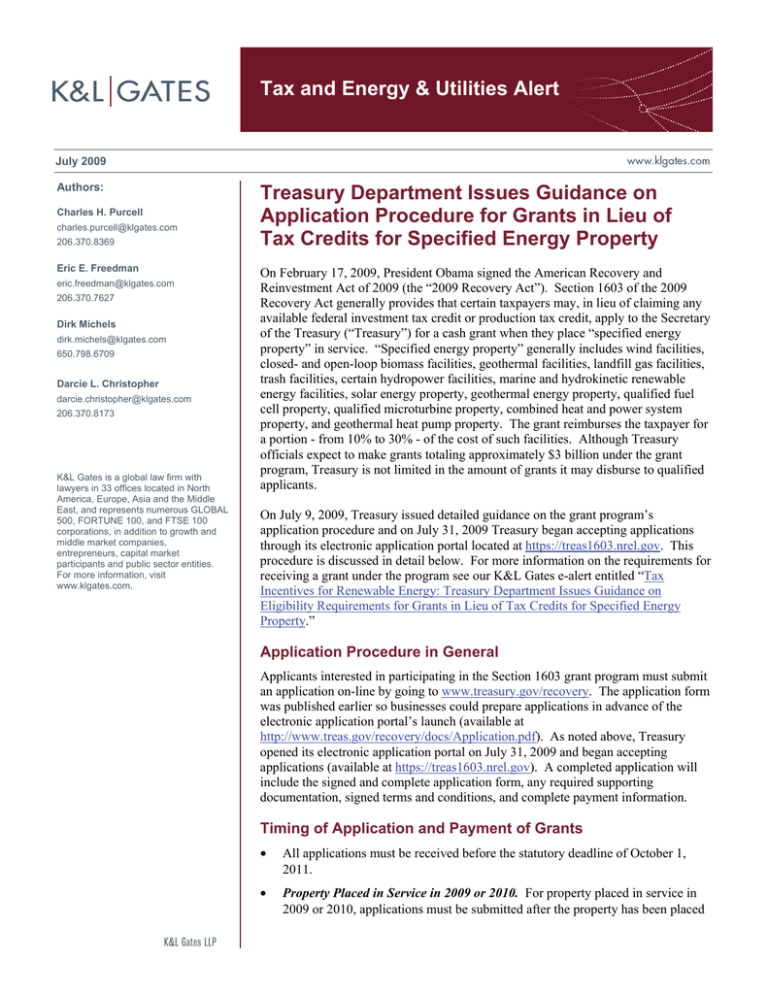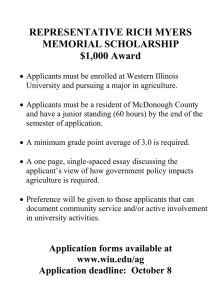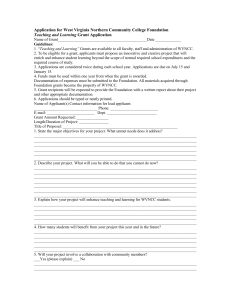
Tax and Energy & Utilities Alert
July 2009
Authors:
Charles H. Purcell
charles.purcell@klgates.com
206.370.8369
Eric E. Freedman
eric.freedman@klgates.com
206.370.7627
Dirk Michels
dirk.michels@klgates.com
650.798.6709
Darcie L. Christopher
darcie.christopher@klgates.com
206.370.8173
K&L Gates is a global law firm with
lawyers in 33 offices located in North
America, Europe, Asia and the Middle
East, and represents numerous GLOBAL
500, FORTUNE 100, and FTSE 100
corporations, in addition to growth and
middle market companies,
entrepreneurs, capital market
participants and public sector entities.
For more information, visit
www.klgates.com.
Treasury Department Issues Guidance on
Application Procedure for Grants in Lieu of
Tax Credits for Specified Energy Property
On February 17, 2009, President Obama signed the American Recovery and
Reinvestment Act of 2009 (the “2009 Recovery Act”). Section 1603 of the 2009
Recovery Act generally provides that certain taxpayers may, in lieu of claiming any
available federal investment tax credit or production tax credit, apply to the Secretary
of the Treasury (“Treasury”) for a cash grant when they place “specified energy
property” in service. “Specified energy property” generally includes wind facilities,
closed- and open-loop biomass facilities, geothermal facilities, landfill gas facilities,
trash facilities, certain hydropower facilities, marine and hydrokinetic renewable
energy facilities, solar energy property, geothermal energy property, qualified fuel
cell property, qualified microturbine property, combined heat and power system
property, and geothermal heat pump property. The grant reimburses the taxpayer for
a portion - from 10% to 30% - of the cost of such facilities. Although Treasury
officials expect to make grants totaling approximately $3 billion under the grant
program, Treasury is not limited in the amount of grants it may disburse to qualified
applicants.
On July 9, 2009, Treasury issued detailed guidance on the grant program’s
application procedure and on July 31, 2009 Treasury began accepting applications
through its electronic application portal located at https://treas1603.nrel.gov. This
procedure is discussed in detail below. For more information on the requirements for
receiving a grant under the program see our K&L Gates e-alert entitled “Tax
Incentives for Renewable Energy: Treasury Department Issues Guidance on
Eligibility Requirements for Grants in Lieu of Tax Credits for Specified Energy
Property.”
Application Procedure in General
Applicants interested in participating in the Section 1603 grant program must submit
an application on-line by going to www.treasury.gov/recovery. The application form
was published earlier so businesses could prepare applications in advance of the
electronic application portal’s launch (available at
http://www.treas.gov/recovery/docs/Application.pdf). As noted above, Treasury
opened its electronic application portal on July 31, 2009 and began accepting
applications (available at https://treas1603.nrel.gov). A completed application will
include the signed and complete application form, any required supporting
documentation, signed terms and conditions, and complete payment information.
Timing of Application and Payment of Grants
•
All applications must be received before the statutory deadline of October 1,
2011.
•
Property Placed in Service in 2009 or 2010. For property placed in service in
2009 or 2010, applications must be submitted after the property has been placed
Tax and Energy & Utilities Alert
in service and before October 1, 2011. For this
purpose, property is placed in service when it is
ready and available for its specific use. Treasury
will review the application and make payment to
qualified applicants within 60 days from the
date the completed application is received.
•
Property under Construction. For property not
placed in service in 2009 or 2010, but for which
construction begins in 2009 or 2010,
applications must be submitted after
construction commences, but before October 1,
2011. Construction begins when physical work
of a significant nature begins. For purposes of
these rules, an applicant may treat physical work
of a significant nature as beginning when the
applicant incurs or pays more than 5% of the
total cost of the property.
•
Timing of Payments. If the property has been
placed in service at the time of the application,
Treasury will make payments to qualified
applicants within 60 days from the date the
completed application is received. For property
not yet placed in service at the time of the
application, Treasury will review such
applications and notify the applicant if all
eligibility requirements that can be determined
prior to the property being placed in service
have been met. If so notified, applicants must
then submit, within 90 days after the date the
property is placed in service, supplemental
information sufficient for Treasury to make a
final determination. Treasury will make a final
review of the application at that time and make
payment to qualified applicants within 60 days
after the supplemental information is received.
Required Documentation
•
Supporting Documentation. Applicants must
submit certain supporting documentation
demonstrating that the property is eligible
property and that it has been placed in service
or, if placed in service after December 31, 2010,
that construction began in 2009 or 2010. For
example, to demonstrate that property is
eligible, all applicants must submit final
engineering design documents, stamped by a
licensed professional engineer. To demonstrate
that property has been placed in service, an
applicant must submit a commissioning report
and (if applicable) an interconnection
agreement.
•
Additional Documentation for Property under
Construction. For property that is under
construction but not yet placed in service,
applicants must submit paid invoices or other
documents demonstrating that physical work of
a significant nature has begun. For such
property that is being manufactured,
constructed, or produced for the applicant by
another person, the applicant must submit the
binding contract for the manufacture,
construction, or production of the property.
Where the applicant is the lessee of the
property, the applicant must submit the written
agreement with the lessor.
•
Documentation Supporting Cost Basis. In
addition, applicants must submit documentation
that supports the cost basis claimed for the
property, including a detailed breakdown of all
costs included in the property’s basis.
Additional supporting documentation, such as
contracts, copies of invoices, and proof of
payment, must be retained by the applicant and
made available to Treasury upon request. For
properties that have a cost basis in excess of
$500,000, applicants must submit an
independent accountant’s certification attesting
to the accuracy of all costs claimed as part of
the basis of the property.
Terms and Conditions
Applicants must agree to the specific terms and
conditions applicable to the Section 1603 grant
program. A copy of the terms and conditions is
available at www.treas.gov/recovery/docs/energyterms-and-conditions.pdf.
•
Representations Required under the Terms
and Conditions. Under the terms and
conditions, which must be signed by an
authorized official of the applicant under
penalties of perjury, an applicant represents that
it is eligible for the Section 1603 grant program,
July 2009
2
Tax and Energy & Utilities Alert
and that it will not claim the production or
investment tax credit with respect to the
property described in the application.
Furthermore, an applicant agrees to maintain,
and provide access to, records sufficient to
demonstrate that the grant funds were properly
obtained in accordance with the Section 1603
program. It is important to note that an
applicant’s obligations under the terms and
conditions continue even after a disposition of
the property to an eligible entity.
•
Annual Project Performance Reports. Under
the terms and conditions, applicants agree to
submit annual project performance reports to
Treasury, and must annually certify to Treasury
that the property has not been disposed of to a
disqualified person and that the property
continues to qualify as specified energy property
(i.e., that a recapture event has not occurred).
Dun and Bradstreet, it must request one by
calling 1-866-705-5711.
•
Treasury Determination and Payment
•
Notification of Application Approval. If
Treasury determines that an application is
approved, it will send a notice to the applicant.
Treasury will make the payment to the applicant
no later than 5 days from the date of the notice.
Payment is made by Electronic Funds Transfer
based upon the banking information in the
CCR.
•
Request for Additional Information. If an
applicant submits insufficient information,
Treasury will notify the applicant and give the
applicant 21 days from the date of the notice to
submit additional information. If additional
information is not received within the 21-day
period, Treasury will deny the application.
•
Denial of Application. If Treasury determines
that an applicant does not qualify for payment,
Treasury will notify the applicant and include
the reason(s) for its determination. The
notification will be considered the final agency
action on the application.
Additional Procedural Provisions
•
•
Multiple Units of Property. Applicants
applying for Section 1603 grants for multiple
units of property that are treated as a single,
larger unit of property (i.e., that are functionally
interdependent) may file a single application for
all such units of property.
Data Universal Numbering System. If an
applicant does not already have a Data Universal
Numbering System (“DUNS”) number from
Central Contractor Registration. Before a
grant payment can be made, an applicant must
also register with the Central Contractor
Registration (“CCR”) by going to
www.ccr.gov/startregistration.aspx.
Anchorage Austin Beijing Berlin Boston Charlotte Chicago Dallas Dubai Fort Worth Frankfurt Harrisburg Hong Kong London
Los Angeles Miami Newark New York Orange County Palo Alto Paris Pittsburgh Portland Raleigh Research Triangle Park
San Diego San Francisco Seattle Shanghai Singapore Spokane/Coeur d’Alene Taipei Washington, D.C.
K&L Gates is a global law firm with lawyers in 33 offices located in North America, Europe, Asia and the Middle East, and represents numerous
GLOBAL 500, FORTUNE 100, and FTSE 100 corporations, in addition to growth and middle market companies, entrepreneurs, capital market
participants and public sector entities. For more information, visit www.klgates.com.
K&L Gates comprises multiple affiliated partnerships: a limited liability partnership with the full name K&L Gates LLP qualified in Delaware and
maintaining offices throughout the United States, in Berlin and Frankfurt, Germany, in Beijing (K&L Gates LLP Beijing Representative Office), in
Dubai, U.A.E., in Shanghai (K&L Gates LLP Shanghai Representative Office), and in Singapore; a limited liability partnership (also named K&L
Gates LLP) incorporated in England and maintaining offices in London and Paris; a Taiwan general partnership (K&L Gates) maintaining an office in
Taipei; and a Hong Kong general partnership (K&L Gates, Solicitors) maintaining an office in Hong Kong. K&L Gates maintains appropriate
registrations in the jurisdictions in which its offices are located. A list of the partners in each entity is available for inspection at any K&L Gates office.
This publication is for informational purposes and does not contain or convey legal advice. The information herein should not be used or relied upon
in regard to any particular facts or circumstances without first consulting a lawyer.
©2009 K&L Gates LLP. All Rights Reserved.
July 2009
3



